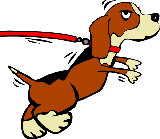Dog SuppliesSnap-around Collars For Dogs |
|
|
The following are three steps to place a snap-around collar on your dog. 1. Start with you and your dog facing each other. Take the clasp in your left hand and the two rings in your right hand. 2. Place the collar under your dog's neck and bring the ends up to the top of his neck, directly behind the ears. When you begin to put on the collar, the dog flexes his neck muscles, expanding the circumference of the neck and creating the impression that the collar is much tighter than it actually is (similar to the effect produced by a horse taking in air as it is being saddled). 3. Attach the clasp to the floating ring. The smooth side of the clasp should be next to the dog's skin. You may get the impression that the collar is much too tight and that you can barely get it around your dog's neck. It is recommended that you wait for about five minutes after the first time you put the collar on. After the dog has relaxed, you can then test for correct snugness. You should be able to easily slip two fingers between the collar and your dog's neck. Use one finger if you have a toy dog. If you cannot, the collar is too tight. On the other hand, if you can get three or more fingers through, the collar is too loose. One way to make the collar smaller is to tie a knot in it. Once you have the collar on, you can use it as a training collar by attaching the leash to the live ring of the collar or as a buckle collar by attaching it to the dead ring of the collar. The live ring of the training collar is called the stationary ring while the dead ring of the collar is referred to as the floating ring. Some dogs do not respond well to a check on a snap-around collar because the check does not create an unpleasant experience for the dog. Therefore, he does not learn to accept the responsibility for his behavior. Also, the dog's size and weight in relation to your size and weight may be such that he does not feel your check.Back to the Dog Supplies page
| |
|
Related News About Dogs ' ); // get rid of newsfeed display by carp CarpConf('poweredby',''); CarpCacheShow('http://dogguidance.com/dogblog/feed'); ?>
|
|
|
|
|
|
Copyright © 2006-2007 dogguidance.com |


